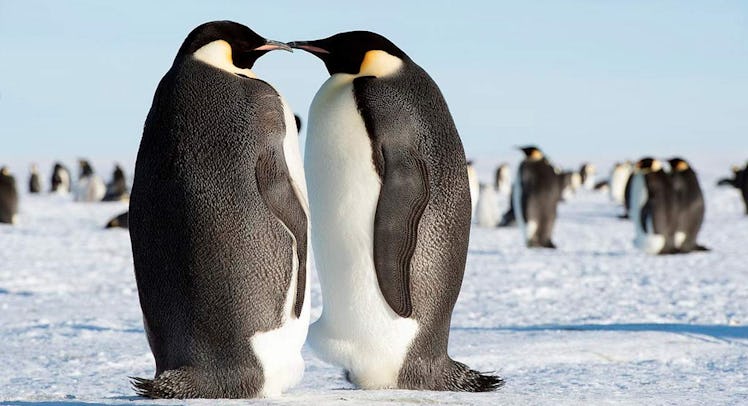The Best Parenting Power Couples In The Animal Kingdom
True animal kingdom power couples.

Parenting relationships in the animal kingdom aren’t great. Okay, they’re pretty much terrible. Between the number of walk out fathers, husbands who eat their wives (ahem Black Widow spiders), wives who eat their husbands, and parents who have an appetite for their own young (looking at you, Mr. goby fish), the animal kingdom is one big Jerry Springer episode. But that doesn’t mean there aren’t some upstanding examples of couples that work together to keep their young alive and well. In fact, they’re more common that you might think. Here are 5 species where mom and dad use teamwork to make the animal kingdom dream work.
Emperor Penguin Couples Split Duties Down The Middle
For the famous Emperor penguins, parenting is a true team effort. In winter, after mom lays a single egg, she peaces out for the open ocean on a 2-month hunting trip. The stay-at-home dads then buckle down on the ice, huddling together for warmth, each balancing an egg on their feet. To keep the egg warm, they cover it with a flap of skin (it’s called a brood pouch, FYI) and then wait. And wait some more. For 2 months.
Eventually, the moms return with bellies full of krill and squid that they then regurgitate into the mouths of their just-hatched chicks. The starving (and probably stir-crazy) dads then head off on their own hunting trip while the moms brace themselves for the terrible toddler phase of parenting.
Seahorse Couples Bust Through Traditional Gender Roles
Male seahorses may be the most covetable spouse in all the animal kingdom. Not only are they true monogamists who mate for life, but they also bear their children. That’s right, when male and female seahorses mate (presumably after a romantic dinner of plankton), they connect tubes through which the female sends her egg into her man’s pouch. Dad then fertilizes the eggs and keeps them snug for the 2-to-3 week gestation period. His wife tends to his needs (and probably gives him a back massage) until he expels his new brood. The parents don’t do anything to tend to their newborns (only 5 in every 1,000 make it to adulthood); instead, the mom prepares to impregnate their husbands again.
Wikimedia Commons
Nile Crocodiles Tag Team Nurturing Responsibilities
Nile crocodiles needs to have their reputation repaired. Yes, they’re dangerous, indiscriminate killers responsible for hundreds of deaths a year But the massive creatures (the largest measured have reached lengths of 20 feet long and 2,400 pounds) are among the most caring reptilian parents. In general, reptiles do their best to make sure their eggs are laid in a safe spot, but beyond that parenting is largely an unknown concept. Mother and father Nile crocodiles, however, aggressively guard their eggs until they’re hatched. They even go so far as to roll them gently in their mouths to keep them warm.
Clownfish Are The Original Helicopter Parents
Because it was a Pixar movie and has to start with something devastating, Finding Nemo focuses on a single dad. But clownfish moms and dads make one hell of a power couple. Proof: Before eggs are laid, they scrub down the sea anemone they call home with a level of OCD that makes Danny Tanner seem sane. When the anemone is spotless, mom lays her eggs and dad attentively polishes each until they hatch. Both parents wave their fins to give their soon-to-be brood a healthy supply of oxygen. Is there such a thing as smothering when kids haven’t been born yet?
Caribbean Flamingo Parents Cough The Color Into Their Children
Once their babies come screaming into this world, male and female Caribbean flamingos play the role of nutritionist. Each parent takes turns feeding their young by coughing up a nutrient-packed red milk that comes from a special part of their digestive tract. Now, the liquid isn’t actually milk (flamingos don’t have mammary glands) but it is packed with enough fat and protein to ensure their little ones are off to a healthy start until they’re able to handle crustaceans and other solid food. And the red milk is what lends flamingos their distinctive cotton-candy coloring. It is for the kids at least: both moms and dads turn pale after the process. Which is a pretty apt metaphor for parenthood.
This article was originally published on